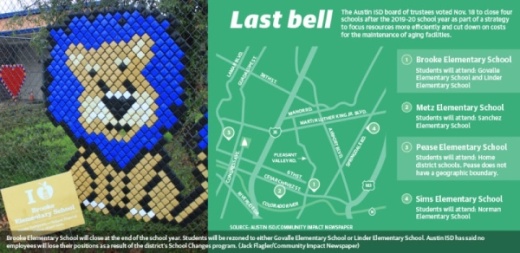“‘What is this place?’” Wilson remembered thinking. “‘We’re in the middle of the city; construction cranes are out. It feels calm and safe and cheerful.’”
In August, Senna started kindergarten at Brooke, and then in November, the district announced Brooke would be one of four schools closing after the 2019-20 school year, along with Pease Elementary School, Metz Elementary School and Sims Elementary School.
Wilson said the morning after the Nov. 18 vote was a difficult one for the entire school community, including Senna.
“That morning, I had to wake her up, and she crumbled when I told her. She started sobbing. She wanted to know why,” Wilson said.
At school, there were hugs at the door before the school day began with the principal, teachers and staff, Wilson said.
“I think I managed to not cry with her. I gave her lots of hugs and reassurances we’d figure it out.”
That process to figure out the next year is not easy, though, according to Wilson, who described the spring semester as “intense” with parents unsure and confused about what will come next.
Brooke’s students will be rezoned to either Govalle Elementary School—for students living north of the Colorado River—or Linder Elementary School—for students south of the river—starting next year. Govalle will open a new $32.6 million modernized campus this semester, and according to district documents, Linder could be modernized in the next bond program.
Wilson said she and many other parents at Brooke are looking into transferring their children to another school during the district’s open-enrollment period, which runs from Jan. 3-31. AISD students are free to attend any school in the district as long as the campus is not on a list of schools frozen to transfers.
District leaders said AISD must close schools in some areas because it needs to reinvest the costs now being spent to maintain older buildings into students, teachers and programs. AISD has too big a property footprint amid falling enrollment, and reducing the number of campuses will allow AISD to stop spending valuable dollars on maintaining old buildings, staff said.
At the unveiling of T.A. Brown Elementary School’s $30.8 million modernized campus in North Central Austin on Jan. 8, AISD board President Geronimo Rodriguez acknowledged the difficult choices made to close four schools in November.
Rodriguez was one of the six board votes to close the schools in a vote that passed 6-3.
“I think the School Changes process that we went through is a difficult journey. This [T.A. Brown modernization] is part of that journey, so we shouldn’t forget that,” Rodriguez said. “We have to have these conversations where, not just our buildings, but the way we look at how we educate our children in the 21st century has to be different and has to meet their needs, not just the adult needs.”
Drew Johnson, AISD’s director of bond planning and controls, said for a district as large as AISD with 130 campuses and more than 81,000 students, the challenges are different in different parts of town. In the eastern areas of the district, for example, enrollments have declined, while some other parts of town are dealing with overcrowding.
“We’ve got to respond to the challenges of the time. They’re always evolving. And that’s what we’re facing now: aging buildings, significant liability on the maintenance of our buildings and declining enrollment,” Johnson said. “If we can solve that by putting more kids in better but fewer schools, in the long run that will be the best decision we can make.”
Wilson does not know where Senna will attend first grade next year—the third time in three years she will be at a new campus—but she said it will be hard to find a place with the same community feeling as Brooke, where Wilson said the community has fostered a sense of “being in this together.”
“That love and that ability to see each kid for who they are is really precious, and honestly it’s hard to find places like that,” Wilson said.





